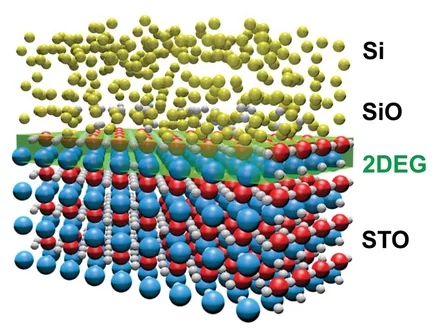Tunable electronic properties of transition-metal oxides and their interfaces offer remarkable functionalities for future devices. The interest in these materials has been boosted with the discovery of a highly mobile 2D electron gas (2DEG) at SrTiO3‐based interfaces. Oxygen vacancies in these systems play a crucial role in the emergence of interface conductivity and ferromagnetism. In this work, A. Chikina et al report a lithography‐like writing of a metallic state at the interface between SrTiO3 and amorphous Si using X‐ray irradiation. Combining transport techniques and operando photoemission spectroscopy at the ADRESS beamline of SLS, they discover that the X‐ray radiation induces transfer of oxygen from SrTiO3 to Si across the interface. This process leads to formation of oxygen vacancies in SrTiO3, which inject electrons into the interfacial 2DEG (see Fig. 1). As the interface oxygen vacancies are stabilized by the Si capping, the 2DEG formed in this way stays stable in ambient conditions. The study provides a fundamental understanding of X‐ray‐induced redox reactions at the SrTiO3‐based interfaces. In the device perspective, the X‐ray induced formation of oxygen vacancies may provide means for the spatially controlled superconductivity, magnetism, and memristive functionalities in oxide heterostructures.
Contact
Dr. Vladimir Strokov
Spectroscopy of Novel Materials Group
Paul Scherrer Institute, Forschungsstrasse 111, 5232 Villigen PSI, Switzerland
Telephone: +41 56 310 53 11
E-mail: vladimir.strocov@psi.ch
Original Publication
X‐Ray Writing of Metallic Conductivity and Oxygen Vacancies at Silicon/SrTiO3 Interfaces
A. Chikina, M. Caputo, M. Naamneh, D.V. Christensen, T. Schmitt, M. Radovic & V.N. Strocov
Advanced Functional Materials, Volume 29, Issue 25, 21 June 2019
DOI: https://doi.org/10.1002/adfm.201900645


